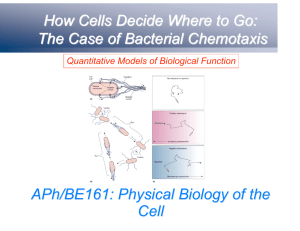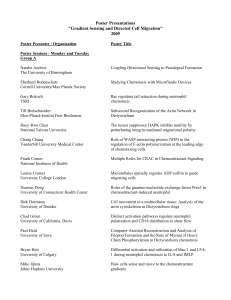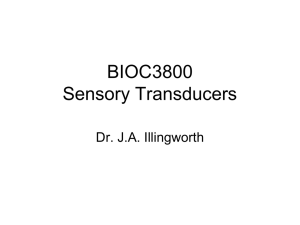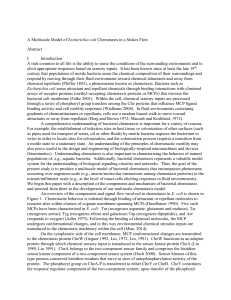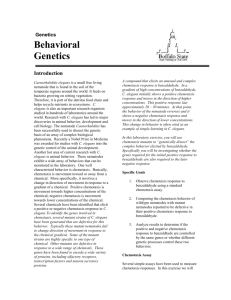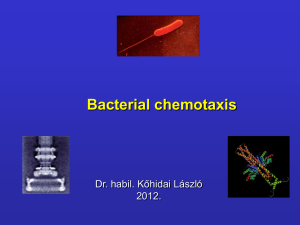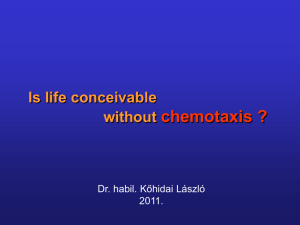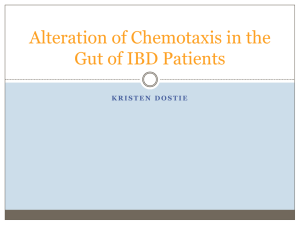Chemotaxis
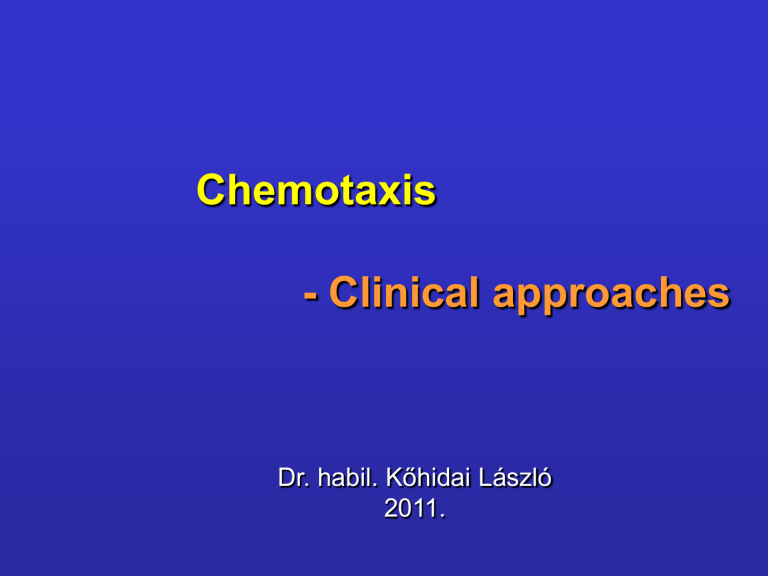
Chemotaxis
- Clinical approaches
Dr. habil. Kőhidai László
2011.
Chemotaxis and infections (1)
Acute skin lesions cytokine release IL-8
TNF ill. IL-6 are NOT released !
Pseudomonas aeruginosa formation of biofilms
Klebsiella pneumoniae chemotactic activity is decreased
Burellosis chemotactic and phagocytotic activity of cells decreased
(6 months follow-up study)
Chemotaxis in infections (2)
Helicobacter pylori gastric ulcer porin 30kD rapid effect decreased chemotaxis
3h incubation TNF
18h incubation g-IF, GM-CSF,
IL-8, IL-3, IL-4
Chemotaxis and infections (3)
AIDS
HIV reservoirs cells: monocyte, macrophage organ: CNS, lung, periph.blood, liver
(The time of replication cycle of virus differes in the different cells – it is different from lymphocyte)
Cell-physiological functions damaged: cytokine (chkemokine) synthesis chemotaxis phagocytosis 2 mths 4 yrs chtx.
-19% phagocyt.
-6%
-32%
-18%
Diseases influencing physiological chemotactic responsiveness (1)
Atherosclerosis
LDL-gly
LDL-ox LDL-gly chemotaxis (monocyte) cytokine secretion thrombocyte aggregation
Amyloidosis Amyloid deposits chr. haemodialysis b-
2-microglobulin chemotaxis TNF IL-1 IL-6
(monocyte) (macrophage)
Diseases influencing physiological chemotactic responsiveness (2)
Glycogen storage diseases chemotaxis
Ca 2+
O-
+ G-CSF bacterial infections are frequent chemotaxis decreased
Ca 2+ norm.
O norm.
Cystic fibrosis Aut. rec. 7q31 lung - LTB4 sputum - IL-8
BUT effect of LTB4 and IL-8 on chemotaxis is inverse
? receptor down-regulation ? number of IL-8 rec. is 1/3 of normal
(22.000/cell)
Diseases influencing physiological chemotactic responsiveness (3)
Lung sarcoidosis and fibrosis levels of MCP-1 and IL-8 are increased influx of neutrophils and monocytes
Kartagener syndrome dynein defficiency decreased chemotaxis
Diseases influencing physiological chemotactic responsiveness (4)
Rheumatoid arthritis chronic inflammation
IL-8 increased chemotaxis
VEGF
(administration of IL-8 can mimic R.A. in experiments)
Asthma bronchiale paroxismal constriction of airways basophils increased chemotaxis biogenic amines are released
Peritonitis
Uveitis
Primer inflammations (1)
- ATP levels in lymphocytes decreased chemotactic activity - decreased
in macrophages chemokinetic activity expressed – induced by MIP-1
(inflammation of the middle layer of the eye) chemotaxis is CD11/CD18 -dependent
Periodontitis TNF ands IL-1 levels of sera are increased
IL-1 increases chemotaxis of neutrophils and the reabsorption of bones
Primer inflammations (2)
Periodontitis levels of TNF and IL-1 in sera are increased
IL-1
PGE1 neutrophil chemotais bone reabsorption inhibits development of inflammation
IGF, FGF, PDGF chemotaxis proliferation differentiation
+ regeneration of osteoblasts
Neutrophil defect of newborns
1 - 8 days
13 - 14 days chemotaxis decreased chemotaxis normalized
1 - 2 day after 3rd day chemokinetic act. normal chemotactic act. decreased
REASON: - low level expression of CD11 integrin
- low level expression of L selectin
Diseases of circulatory system (1)
Circulatory diseases of the heart
Ischemic heart diseases – transient or lasting occlusion of coronary vascular smooth muscle chemoattractants: fibrinogen (free) - chemotx.
fibrinogen (bound) - haptotax.
Diseases of circulatory system (2)
Reperfusion Release of chemoattractants is detectable in the early stage of reperfusion
Invasion of neutrophils guided by E selectins
Diseases of circulatory system (3)
Peripherial blood vessels
Angiogenesis proliferation chemotaxis morphogenesis
Thrombospondin 1 (TSP1) : inhibits chemotaxis and morphogenesis
Reperfusion -strats 24h after a min. 3 hrs occlusion
chemotaxis of PMN cells
Blood vessels in brain
- ischemia results release of FGF
- starts chemotaxis, mitosis, differentiation and angiogenesis
Diabetes
- increased chemokinetic activity of PMN
- antidiabeticums used in therapy can decrease the chemokinetic activity
Primer hypothyreosis - bacterial infections are frequent
- cell adhesion is increased
- chemokinetic activity is decreased
Sclerosis multiplex
- bacterial infections are frequent
- decreased cell adhesion chemotaxis phagocytosis bactericid effects
Hodgkin-disease decreased chemotaxis
Psoriasis
TGFb monocyte adhezion chemotaxis macrophage
Edema in lungs, pmeumothorax(PTX) increased levels of IL-8 and LTB4
Melanoma
Myeloma
Tumours endothelin-1 (ET-1) perivascular chemokinetic effect production of fMLP-like, chemotactic factor
Human leukemia retinoic acid expression of MAC-1 inegrin
Therapy b
-4-integrin expression is decreased chemotaxis decreased
(231-28) chemoinvasion decreased
(132-2)
Toxic diseases (1)
Alcohol
acute:
3 h 24 h
Kupffer cells chtx.
neutrophil 2-3 x fMLF rec.
(K=65.000) increased further
120.000
200.000
(even 30mM ethanol is effective !!!)
chronic: phagocyte disfunction
Nicotine - TNF and IL-6 levels are decreased
- IL-8 level is increased
-function of phagocyte function
(macrophages) is affected
Toxic diseases (2)
Quarz, ozone, NO
2 quarz ozone
NO
2 chemotaxis chemotaxis decreased decreased
, TNF-level increased
TNF-level increased
, TNF-level decreased
Asbestos IL-1
TNF a
IL-8 Chtx. increased
Methyl~ Hg, Si-lactate release of reactive oxygen radicals decreased neutrophil chemotaxis
Mutagenes (benzpyren, 12-dimethyl benzantracen) increased chemotaxis and chemoinvasiveness
BUT
Hypnosis
X
